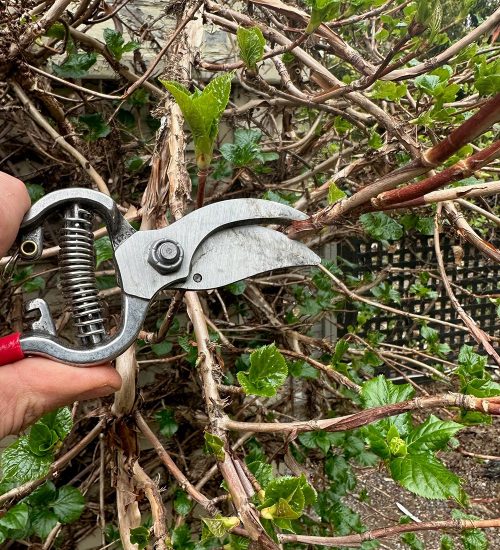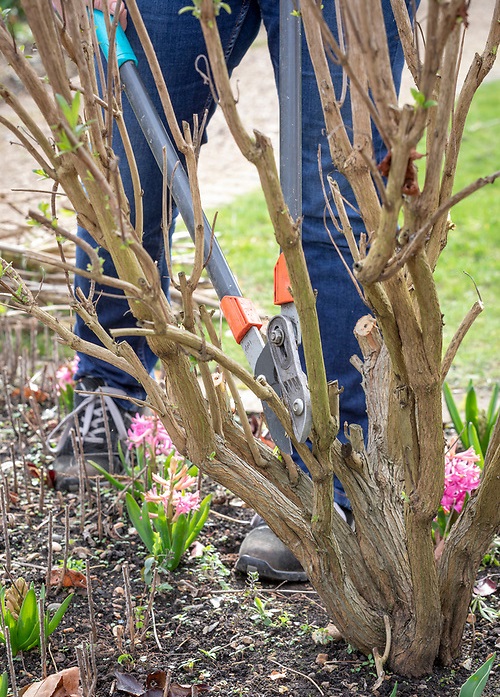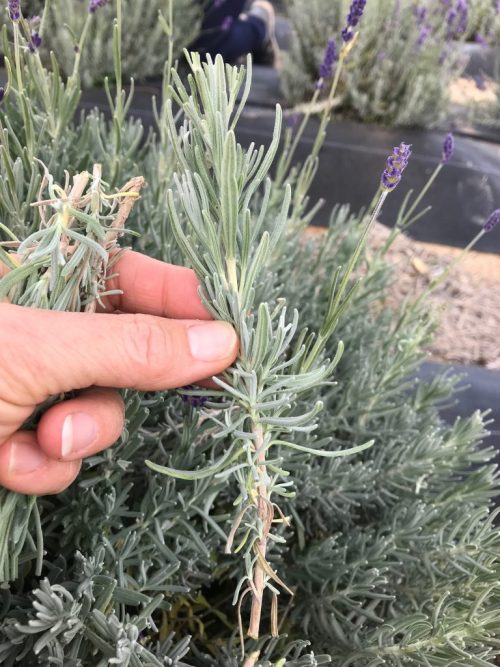Looking for Plants to Grow from Cuttings in Fall? Why not? Autumn is the best time to start perennials, herbs, and shrubs.
When it comes to growing plants from cuttings in the fall-woody shrubs like hydrangea, lilacs, and forsythias, some perennials, herbs, and fruits like figs and grapes can be tried. Excited? Read more below
Why Fall is Suitable for Certain Plants
Plants grow stress-free until the mid-fall due to the cool air and slightly warm soil temperature in this season. They focus on root development in the fall, providing a better environment for cuttings to root. Also, lower temperatures often mean fewer pests, making it easier for new cuttings to survive.
Best Plants for Fall Cuttings
Woody Shrubs and Vines
1. Forsythia
Botanical Name: Forsythia suspensa
The brilliant golden-yellow blooms of Forsythia are a harbinger of spring, adding a splash of color to your garden when most other plants are still dormant.
Aside from its vibrant springtime appeal, Forsythia can be used as a natural border or hedge plant, offering both beauty and privacy to your outdoor space.
Planting Process:
Take 6-8-inch hardwood cuttings from the current year’s growth. Remove leaves from the bottom half of the cutting. Dip the cut end in rooting hormone powder. Insert the cutting into a pot filled with well-drained soil.
Why It’s Best in Fall:
Forsythia enters dormancy in the fall, redirecting energy toward root development. The moist soil conditions in fall enhance root growth.
2. Boxwood
Botanical Name: Buxus
Boxwoods provide evergreen beauty year-round. These hardy shrubs can be easily shaped into intricate designs, perfect for formal gardens or as topiaries.
They serve as excellent foundation plants and can even be grown in pots for a touch of elegance on patios and balconies.
Planting Process:
Take 4-6 inch semi-hardwood cuttings. Strip leaves from the lower third of the cutting. Apply rooting hormone to the cut end and plant in a pot with well-drained, sandy soil.
Why It’s Best in Fall:
Cool-weather and increased rainfall contribute to faster root development. Reduced pest activity ensures a higher survival rate for new cuttings.
3. Honeysuckle

Botanical Name: Lonicera × heckrottii
The blossoms create a striking contrast against its dark green foliage, giving the plant a vivid appeal. During full bloom, the vine gets covered with flowers, which can be a focal point in any garden!
Planting Process:
Take a 6-8 inch cutting from a healthy, disease-free plant. Strip the leaves from the lower half of the cutting. Insert the treated end into a pot filled with well-drained soil. Use a plastic bag or dome to maintain humidity. Keep the soil consistently moist but not waterlogged.
Why It’s Best in Fall:
Less intense sunlight can help reduce stress on new cuttings. Ample moisture in the soil supports root development.
Different Types of Honeysuckle Varieties You Can Grow
4. Hydrangea

Botanical Name: Hydrangea
All hydrangeas can be grown from cuttings in the fall. The plant itself has a woody, rustic character that provides an attractive contrast to the soft blooms. You can learn about growing hydrangeas from cuttings here.
Planting Process
Choose a semi-hardwood cutting that is at least 4-6 inches long. Remove all but the top few leaves. Dip in a rooting hormone and plant in a container with moist, well-draining soil. Use a plastic cover to retain humidity. Keep the soil moist.
Why It’s Best in Fall:
Soil is still warm enough to encourage root growth. The plant’s growth is slower, allowing more energy for root development.
Check landscaping with hydrangeas here
5. Geranium

Botanical Name: Pelargonium
Geranium’s colorful blooms and fragrant foliage make it a very special plant and favorite of many. The best part is you can easily multiply it from cuttings in autumn, which means you can have as many as you want and display them in your garden or containers, bursting with colors.
Planting Process
Snip a standard size cutting just below a leaf node. Remove lower leaves, keeping just 2-3 at the top. Allow the cut end to dry for a few hours to avoid rot. Cover the cuttings with plastic to provide extra humidity. Water sparingly to prevent water logging until roots develop.
Why It’s Best in Fall:
Growing geranium in fall and early winter is a great idea if you live in a frost-free climate.
6. Star Jasmine
Botanical Name: Trachelospermum jasminoides
Star Jasmine is a versatile plant that thrives as long as it gets plenty of sunlight, which makes it flower abundantly. You can grow it for fragrance if you live in USDA Zones 7b to 11 for strong fragrance.
Planting Process
Take a 4-6 inch cutting from a healthy shoot. Remove the leaves from the lower half. Use a pot with well-draining soil. Enclose the pot in a plastic bag. Maintain a moist soil environment.
Why It’s Best in Fall:
Adequate rainfall in fall can help keep the soil moist, aiding root development.
7. Butterfly Bush
Botanical Name: Buddleja
The Butterfly Bush’s nectar-rich flowers attract butterflies, hummingbirds, and other pollinators, adding life and movement to your garden. It can be a great focal point, too, in a small garden when placed in a large container.
Planting Process
Take a cutting, as usual, from a non-flowering branch. Remove the lower leaves and dip the cut end in a rooting hormone. For faster results, you can also try some of these rooting hormones. Insert the cutting into a pot with well-draining soil, covering about 2-3 inches of the stem. Water lightly and place the pot in a location with indirect sunlight. Covering the pot with a plastic bag can help maintain humidity.
Why It’s Best in Fall:
Planting butterfly bush cuttings in the fall allows for a strong root system to develop during the fall and winter months. This makes the plant more robust and better prepared for the spring and summer growing seasons.
However, it’s important to plant early enough in the fall to give the plant sufficient time to root before winter sets in. Otherwise, it can’t be propagated successfully.
Softwood Plants
8. Coleus

Botanical Name: Solenostemon scutellarioides
Coleus is celebrated for its colorful, variegated leaves rather than its blooms. It can bring a pop of color to less sunny areas. It also serves as an excellent companion plant, enhancing the beauty of flowering plants with its contrasting foliage.
Planting Process:
Snip off 3-4 inches of cuttings just below a node. Remove the lower leaves. Insert into a pot with moist, well-draining soil.
Why It’s Best in Fall:
Reduced sunlight intensity minimizes the risk of leaf burn. You can also do it indoors.
9. Impatiens

Botanical Name: Impatiens balsamina
Impatiens are best for shaded or semi-shaded areas. Their vibrant flowers bloom profusely, providing a burst of color in spots where many plants wouldn’t thrive. The compact size makes it perfect for container gardening and smaller raised beds.
Planting Process:
Cut 3-4 inches from the tip of a healthy stem. Place the cutting in a seed-starting mix or experiment with the root in a glass of water. Transplant to a desired pot with rich, well-drained soil.
Why It’s Best in Fall:
Lower temperatures reduce evaporation, maintaining moisture levels. Fewer pests and diseases are present in the fall.
Learn how to grow Impatiens in pots
Herbs
10. Rosemary
Botanical Name: Salvia rosmarinus
Rosemary is the best perennial herb to start in the fall, and if you love fresh rosemary sprigs in your food, don’t miss planting several cuttings in the season. You can learn how to grow rosemary from cuttings here.
Planting Process:
Take 4-6 inch tip cuttings from healthy plants. Remove lower leaves. Dip the cut end into the rooting hormone—plant in a pot filled with well-draining soil.
Why It’s Best in Fall:
Fall is the best month for planting in warm climates, USDA Zones 9-11.
11. Mint
Botanical Name: Mentha
Mint adds a lush green touch to gardens, and its rapid growth provides a constant supply of fresh leaves. As a culinary ingredient, it can be used in many ways: from spicing up salads and beverages like mojitos to flavoring desserts and sauces, you can even make delicious mint chutneys to flavor your food.
Planting Process:
Take many 4-inch cuttings from healthy mint plants. Remove leaves from the bottom 2 inches. Insert the cuttings into a pot with damp, well-draining soil.
Why It’s Best in Fall:
Mint is a hardy plant that thrives even in less-than-ideal conditions, making it suitable for fall planting. The decrease in pest activity enhances survival rates.
12. Lavender

Botanical Name: Lavandula
Lavender’s delicate purple flowers and silvery-green leaves add a splash of color to any garden. Its fragrance is amazing when you brush your hand on it. The leaves have a slightly sweet flavor that works well in desserts, teas, and some savory dishes.
Planting Process:
Start by cutting 4-6 inches from a healthy parent plant. Remove the lower leaves, leaving only a couple of leaves at the top. Plant the cutting in a pot filled with well-draining soil, burying about 1-2 inches of the stem. Water lightly and place the pot in a bright location but out of direct sunlight.
Why It’s Best in Fall:
Fall is an excellent time to plant lavender cuttings as the moderate temperatures help root development without the risk of the cutting drying out, which is often the case in hot summer months. Additionally, planting in fall gives the plant ample time to establish its root system before the hot weather arrives, making it more resilient and drought-tolerant for the upcoming summer.
Ornamental Grasses
13. Pampas Grass

Botanical Name: Cortaderia selloana
The tall, feathery plumes of Pampas grass make it a popular choice for modern outdoor settings. The plant can serve as a natural privacy screen or a focal point in any landscape design and adds visual appeal, especially to the borders.
Planting Process:
Use divisions of healthy parent plants. Plant the divisions in a hole as deep as the root ball. Backfill with soil and water thoroughly.
Why It’s Best in Fall:
Cool temperatures and sufficient moisture aid in root establishment. Lower light levels reduce stress on new plants.


